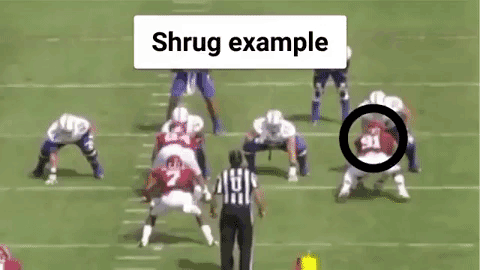Teaching block release
I've seen it to often where a young D-Lineman does a great job knocking back their opponent and locking out, but because they don't release correctly they miss an opportunity to make a backfield tackle.
In today's D-Line Examples I'll show you exactly when and how to release so this doesn't happen to you.
Create separation
The first order of business is to create separation between you and your opponent.
To do this strike your opponent with arms extended, inside hands and low pad level (eyes below your opponent's) so you have leverage to lock him out.
Read the back
Once you're locked out, next step is to peak around the blocker and read the path of the back.
The back's pad will either be perpendicular or square to the LOS.
Swim or shrug if square
If the back's pads are square and in the tackle box, use a swim or shrug release.
To swim release, tug the blocker with your outside arm, reach with your foot and seal of the blocker with the swim.
And to shrug do exactly what you would do with a swim release, but tug with 2 hands instead of 1.
Now why only use swim or shrug in this situation?
It's because as long as you got the threat of cut back you have to be able to escape to either your primary and secondary gap. Both the shrug and swim release give you the ability to do this.
Rip if perpendicular
On the other hand, if the back's pads are perpendicular (and on a path outside the box), use a rip release by turning your hips, ripping the arm and pointing your toe to the sideline.
Because there is no threat of cut back, the most efficient way for you to make the play is to turn your hips and rip.
Thank you all for your support!
And whenever you are ready, there are 2 ways I can help you:
Learn how to develop top tier pass rushers and a lethal pass rush attack here (1,000+ students)
Learn how to turn your D-Line into a block destruction machine here (1,100+ students)
-Craig







